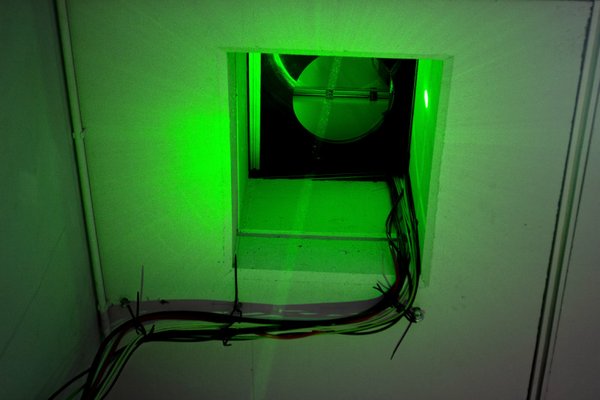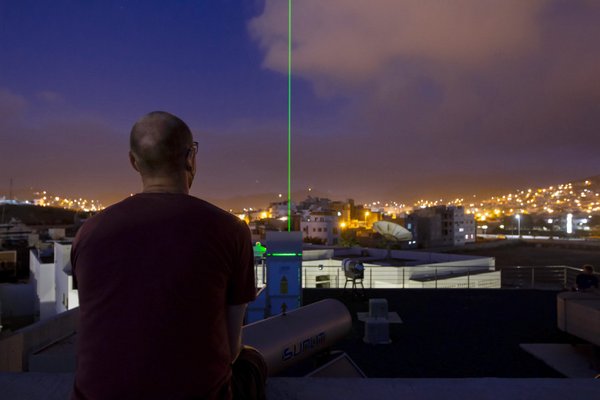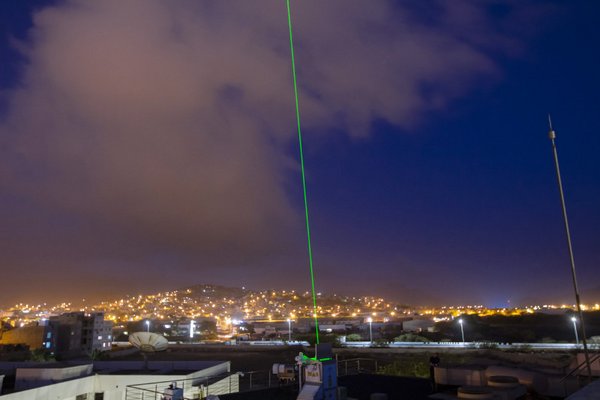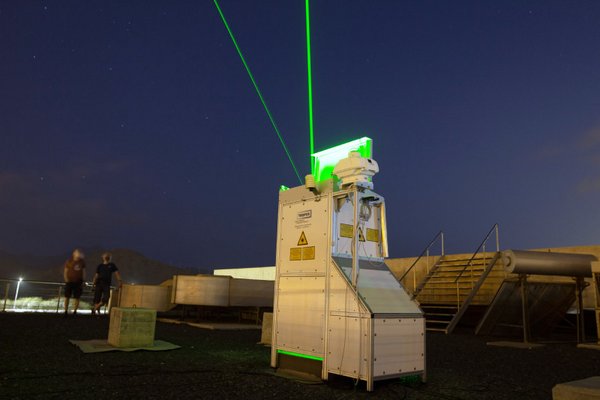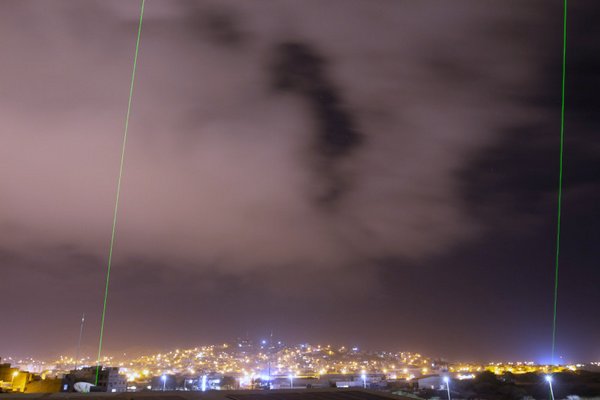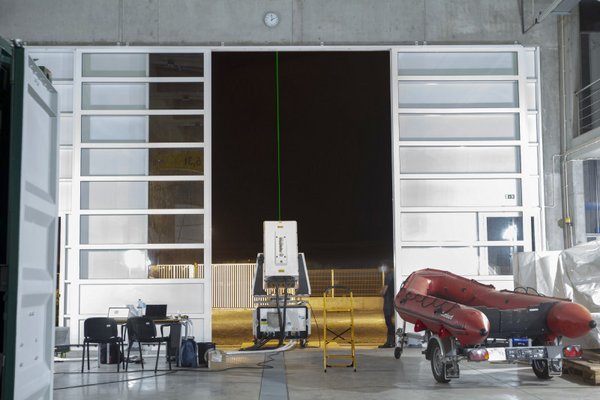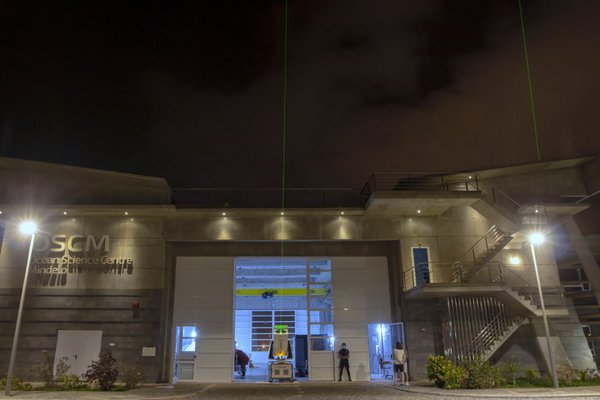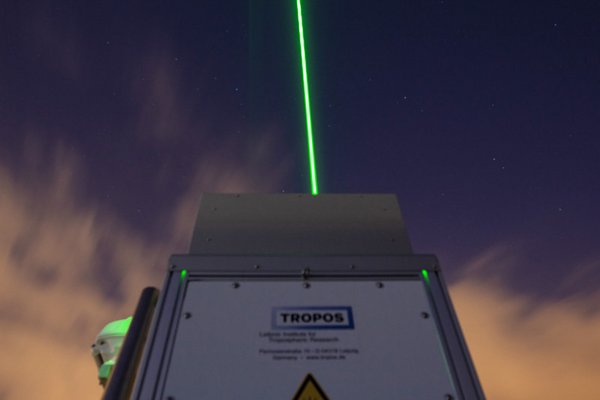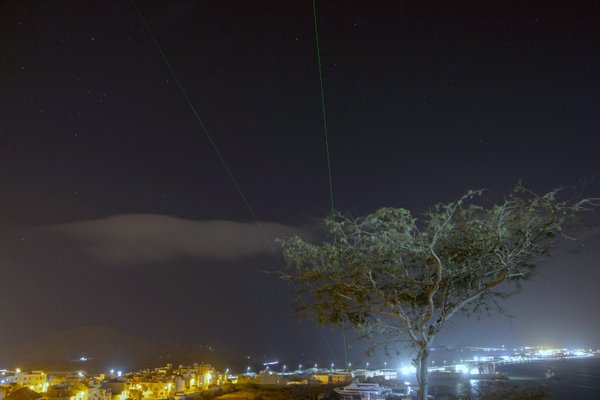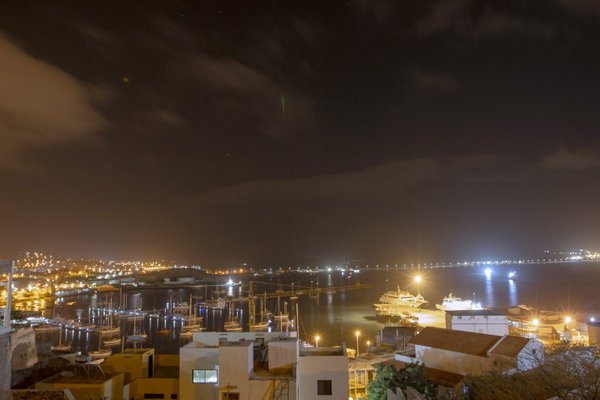Large measurement campaign in the Atlantic starts
Mindelo,
30.06.2021
TROPOS lidar on Cabo Verde in operation for the ESA wind satellite Aeolus
Mindelo/Leipzig. To support the ESA wind satellite Aeolus, the Leibniz Institute for Tropospheric Research (TROPOS) has now installed a lidar in Mindelo, the second largest city in Cabo Verde. The light radar uses laser light to study the atmosphere in the tropical Atlantic and is part of a large international measurement campaign: The "Aeolus Tropical Atlantic Campaign" will take place in summer and autumn 2021 and, in addition to the validation of the data from the ESA satellite, will also contribute to the research on clouds and aerosols in the tropics and to better understand the formation of tropical cyclones (hurricanes). Various research aircraft are scheduled to investigate the atmosphere above Cabo Verde in September. The measurements from the ground, however, have started already now to perform parallel observations to the lidar measurements from space during the main dust season in the tropical Atlantic.
Since August 2018, a new type of satellite, Aeolus, has been actively measuring wind from space and thus is helping to improve weather forecast. On board this satellite from the European Space Agency (ESA) is the Atmospheric Laser Doppler Instrument (ALADIN), a high-performance laser. ALADIN is the first instrument in space that can actively measure vertical profiles of wind speed. It uses the principle of a light radar (short: Lidar from "LIght Detection And Ranging"). A short laser light pulse is emitted 50 times per second and the reflected radiation (backscatter) from the atmosphere is measured in dependence of time . The time it takes for the light to travel the way to the molecules or particles in the atmosphere that are reflecting and the way back provides information about location or distance. The wind speed at different heights in the atmosphere is then determined with the help of the Doppler effect. Furthermore, Aeolus is able to deliver aerosol and cloud optical properties as spin-off product. To validate the laser measurements in space, they are compared with laser measurements from the ground among others.
The validation of Aeolus products is particularly important in the tropics, where the Aeolus measurements are expected to have a large positive influence on numerical weather forecasts and Saharan dust outbreaks occasionally disturb the laser signal. The Aeolus tropical campaign is organised by ESA in cooperation with European and US partners: The German Aerospace Center (DLR), the US National Aeronautics and Space Administration (NASA), Météo-France, the Laboratoire atmosphères, milieux, observations spatiales (LATMOS), the Cyprus Institute (CYI), the National Observatory of Athens (NOA), the Leibniz Institute for Tropospheric Research (TROPOS), the University of Nova Gorica (UNG), the Ocean Science Centre Mindelo (OSCM) and many more.
Lidar experts from Germany and Greece have now set up the first special instruments on the Cape Verde Islands as part of this measurement campaign in order to cover already the peak season of Saharan dust transport from Africa towards the Atlantic in June/July. The National Observatory of Athens (NOA) will install the lidar system EVE, which can measure the linear and circular depolarisation of backscattered laser light at a wavelength at 355 nanometres. TROPOS has installed PollyXT, a lidar system that can measure extinction and linear depolarisation at three wavelengths (355, 532 and 1064 nanometres). The depolarisation ratio indicates how much the polarisation of the backscattered light is changed and thus allows conclusions about the type of particles in the atmosphere. Both lidar systems will measure the aerosols above Mindelo and thus help to better interpret the satellite's data in dust situations. For this purpose, the satellite's settings are specially changed: For the campaign, the vertical resolution of Aeolus will be adjusted in the region around Cabo Verde in order to better resolve the air layer usually filled with mineral dust from the Sahara, the so-called "Saharan Air Layer" (SAL). For this purpose, Aeolus measures between the ground and an altitude of 5 kilometres with a vertical resolution of 500 metres. The measurement campaign also brings a premiere: "Never before the orbit of the satellite was changed since Aeolus reached its current orbit after launch. But to ensure that the lidar instruments on the ground measure exactly the same layer of air that Aeolus measures, in mid-June Aeolus drifted about 90 km to the east and will then remain there for the rest of its lifetime," explains Dr Sebastian Bley from TROPOS, who has been involved in the Aeolus project at the European Space Agency's (ESA) ESRIN research centre for the past three years.
Originally, extensive airborne measurements with research aircraft from Germany, Slovenia and the USA were planned for June/July in addition to these ground measurements. However, due to the COVID-19 pandemic, the aircraft measurements were postponed to September. The NOA and TROPOS measurements will therefore continue at least until September to measure together with the aircraft and generate a data set never before seen on this scale.
The PollyXT from TROPOS started to continuously investigate the atmosphere from 29 June to study the atmosphere over Cabo Verde. Its green laser beam can be seen at night over the port of Mindelo, but is harmless to both, people and the environment. The device was installed on the roof of the Ocean Science Centre Mindelo (OSCM). The OSCM is a joint cooperation of GEOMAR Helmholtz Centre for Ocean Research Kiel and the National Marine Research Institute of the Republic of Cabo Verde - Instituto do Mar (IMar). It serves the partners for their research and training purposes as well as the international marine research community as a basis for campaigns in the region and events. With TROPOS, another institution is now joining the centre and expanding the research spectrum to include atmospheric research in a region where continuous climate data have been scarce until now.
Cabo Verde is a republic consisting of the Cape Verde Islands with nine inhabited islands in the tropical Central Atlantic, 570 kilometres off the west coast of Africa. Strong trade winds often transport desert dust and smoke from forest fires on the continent to the islands, making it a hotspot for studies of cloud-aerosol interactions as well as the long-range transport of aerosol on a global scale. TROPOS has already been operating the Cape Verde Atmospheric Observatory (CVAO) on the Cape Verdean island of São Vicente for aerosol in-situ research together with the Meteorological Service of the Republic of Cabo Verde (INMG) and the University York and the Max Planck Institute for Biogeochemistry Jena since 2007. Now active remote sensing become a new integrated part on that island. Tilo Arnhold
Contacts:
Dr Dietrich Althausen,
Scientific staff, TROPOS Department "Remote Sensing of Atmospheric Processes",
Phone +49-341-2717-7063,
https://www.tropos.de/en/institute/about-us/employees/dietrich-althausen
and
Dr Holger Baars/ Martin Radenz/ Sebastian Bley
Scientific staff, TROPOS Department "Remote Sensing of Atmospheric Processes",
Phone +49-341-2717-7314, -7312, - 7171
https://www.tropos.de/en/institute/about-us/employees/holger-baars
https://www.tropos.de/en/institute/about-us/employees/martin-radenz
https://www.tropos.de/en/institute/about-us/employees/sebastian-bley
and
Cordula A. Zenk
Ocean Science Centre Mindelo Executive Officer (GEOMAR)
Phone +49 431 600-4209
www.oscm.cv
or
Tilo Arnhold
Public relations
Leibniz Institute for Tropospheric Research (TROPOS)
Phone +49-341-2717-7189
https://www.tropos.de/en/current-issues/press-releases
Links:
Ocean Science Centre Mindelo (OSCM):
https://www.oscm.cv/
NOA website on the tropical Aeolus campaign:
https://askos.space.noa.gr/
Near-real time display of the lidar observations:
https://polly.tropos.de/
Modelling Saharan dust transport:
https://www.tropos.de/en/institute/departments/modeling-of-atmospheric-processes/transport-processes/transport-of-saharan-dust
Leipziger Staubtag:
https://www.tropos.de/en/current-issues/events-and-lectures/leipziger-staubtag
Publication:
Marinou, E., Amiridis, V., Mavropoulou, I., Baars, H., Kazadzis, S., Rosoldi, M., Ene, D., Barreto, A., Casadio, S., Zenk, C., Sciare, J., Mocnik, G., Kandler, K., Stuut, J.-B., Rodrigez, S., Knipertz, P., Rutz, T., Komppula, M., Daskalopoulou, V., and Hloupis, G. and the ASKOS team: The ASKOS experiment for the validation of Aeolus L2A aerosol product. EGU General Assembly 2021, online, 19–30 Apr 2021, EGU21-13781, https://doi.org/10.5194/egusphere-egu21-13781 , 2021.
The Leibniz-Institute for Tropospheric Research (TROPOS) is member of the Leibniz Association, which connects 96 independent research institutions that range in focus from the natural, engineering and environmental sciences via economics, spatial and social sciences to the humanities. Leibniz Institutes address issues of social, economic and ecological relevance. They conduct knowledge-driven and applied basic research, maintain scientific infrastructure and provide research-based services.
The Leibniz Association identifies focus areas for knowledge transfer to policy-makers, academia, business and the public. Leibniz institutions collaborate intensively with universities – in the form of “Leibniz ScienceCampi” (thematic partnerships between university and non-university research institutes), for example – as well as with industry and other partners at home and abroad.
They are subject to an independent evaluation procedure that is unparalleled in its transparency. Due to the importance of the institutions for the country as a whole, they are funded jointly by the Federation and the Länder, employing some 20,000 individuals, including 10,000 researchers.
The entire budget of all the institutes is approximately 1.9 billion Euros. They are financed jointly by the Federal Government and the Länder. The basic funding of the Leibniz Institute for Tropospheric Research (TROPOS) is therefore financed by the Federal Ministry of Education and Research (BMBF) and the Saxon State Ministry of Science and the Arts (SMWK). The Institute is co-financed with tax revenues on the basis of the budget approved by the Saxon State Parliament.
www.leibniz-gemeinschaft.de/en/home/
www.bmbf.de/en/index.html
https://www.smwk.sachsen.de/
